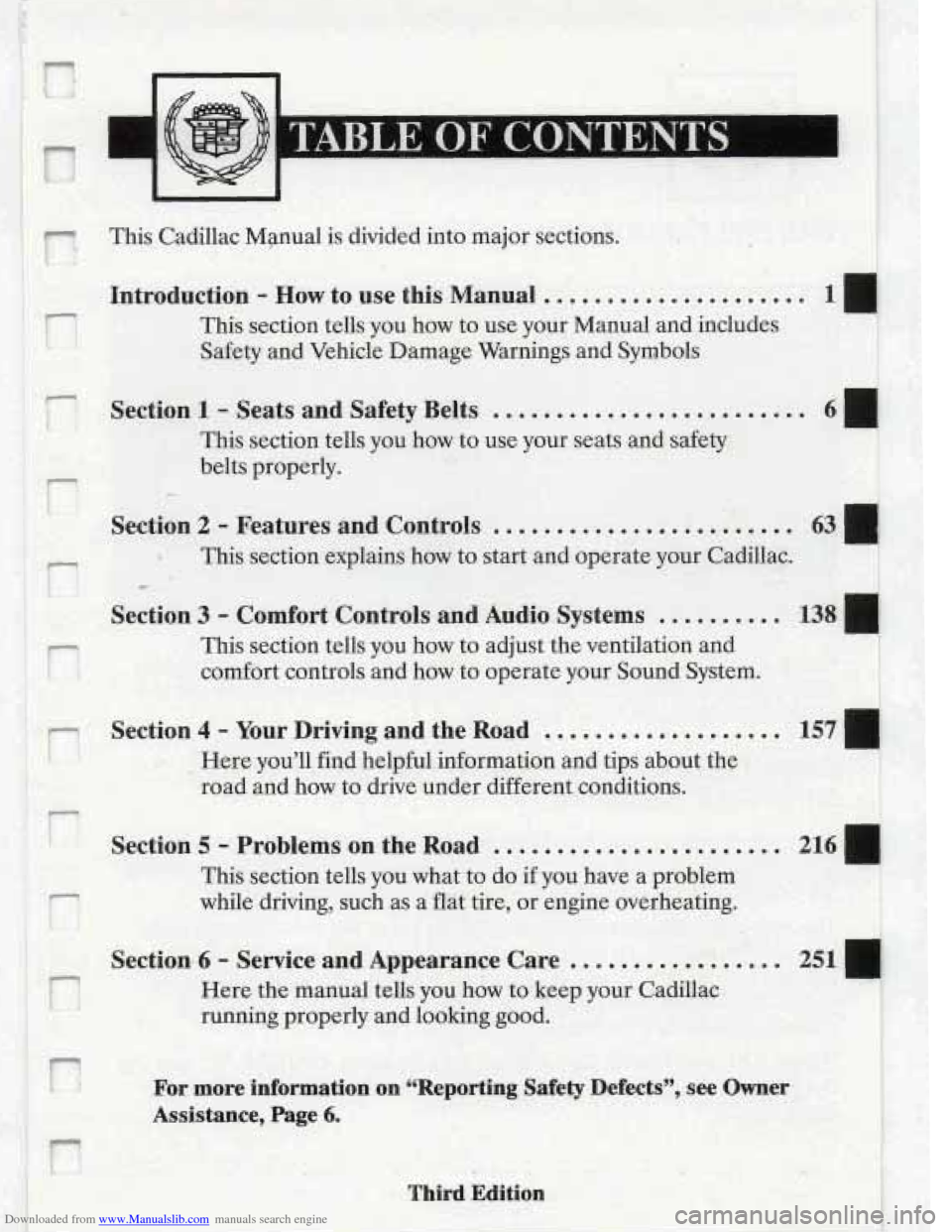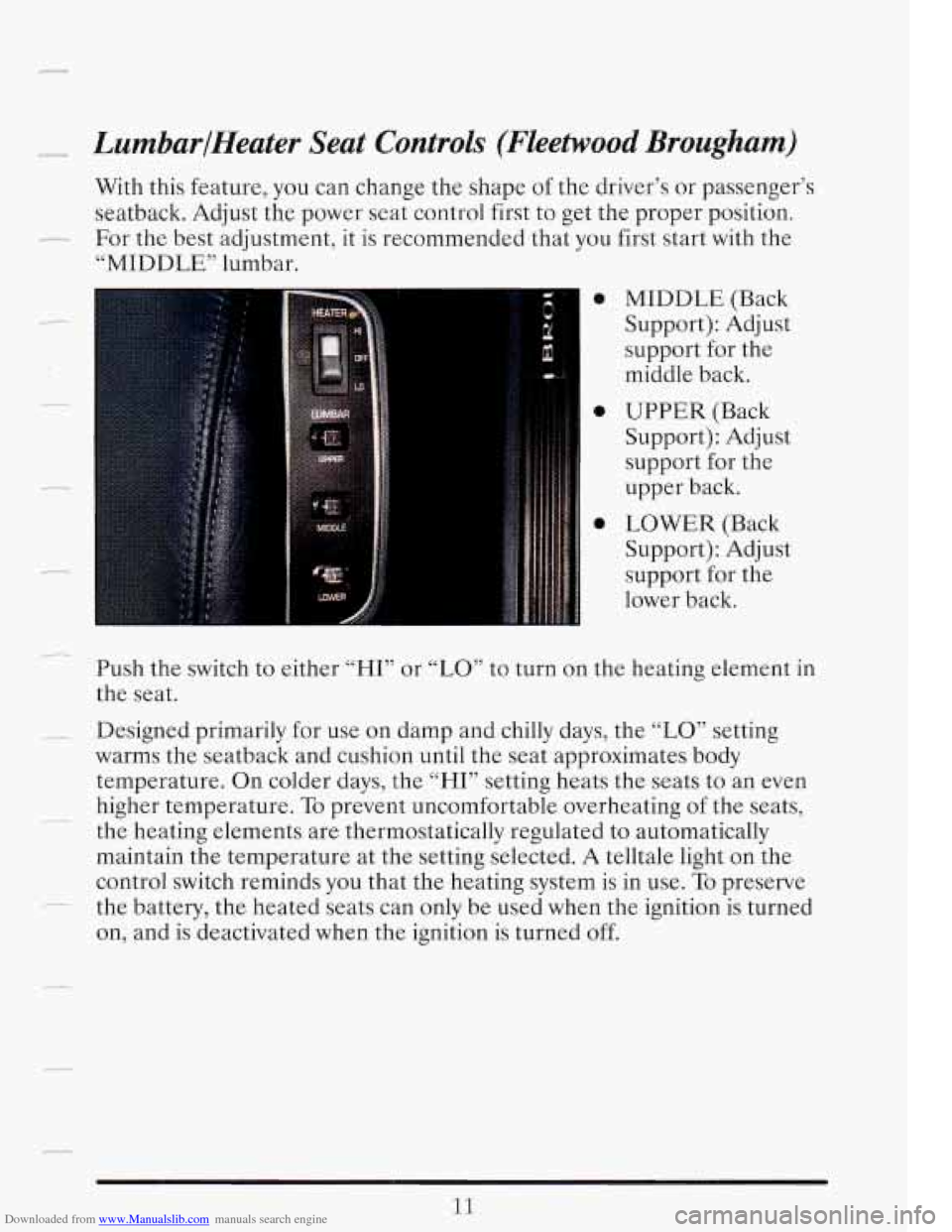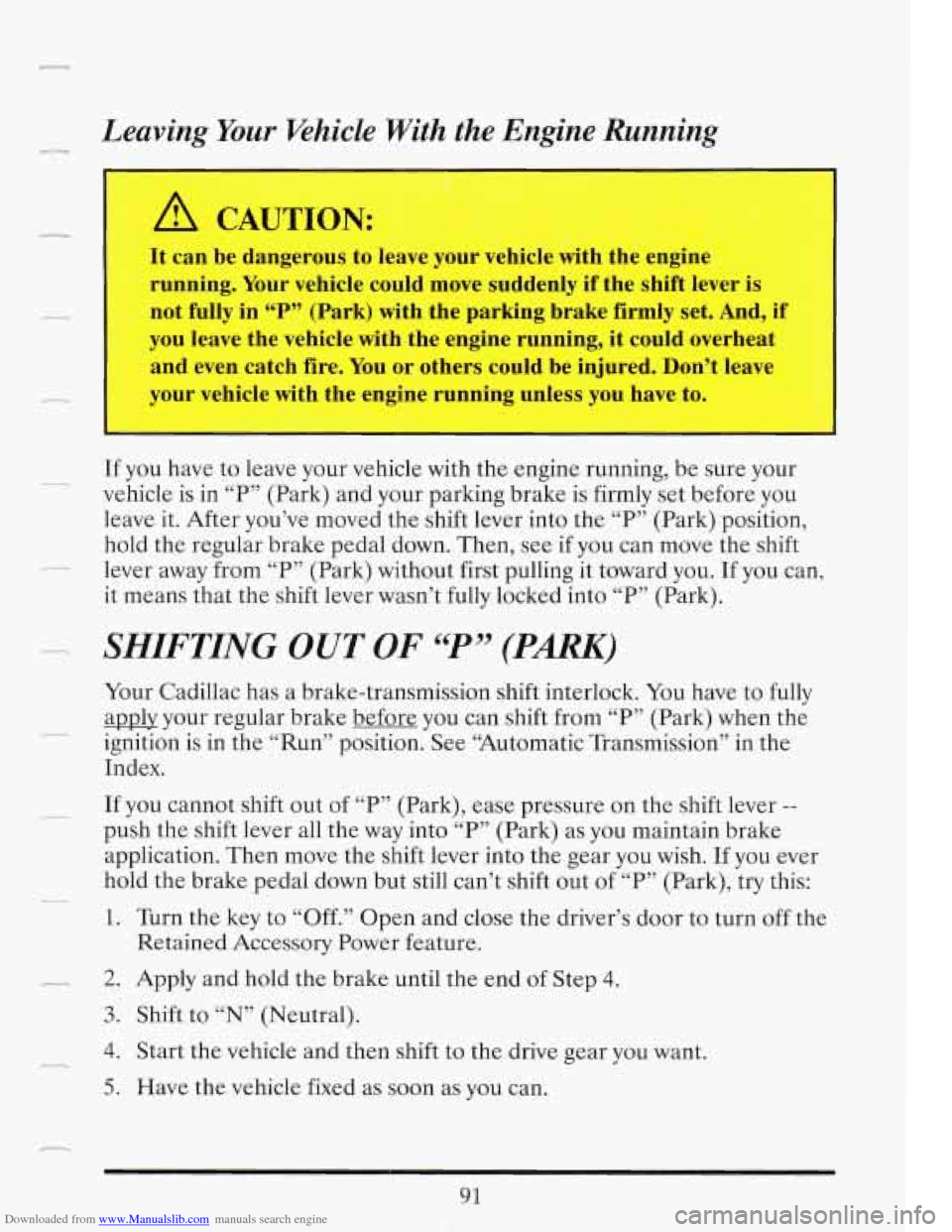Page 13 of 386

Downloaded from www.Manualslib.com manuals search engine r.
r !
r
This Cadillac Mpnual is divided into major sections.
Introduction - How to use this M,anual. .......... ..........
This section tells you how to use your Manual and includes
Safety and Vehicle Damage Warnings and Symbols I ~
Section 1 - Seats and Safety Belts .........................
This section tells you how to use your seats and safety
belts properly.
.--
Section 2 - Features and Controls .................. .A .... 63 :q
Section 3 - Comfort Controls and Audio Systems .......... 138.4
3 This section explains how to start and operate your Cadillac.
c
This section tells you how to adjust the ventilation and
comfort controls and how to operate your Sound System.
section 4 - Your Driving and the Road ................... 157
,. . Here you’ll. find helpful information and tips about the: ..
road and how to drive under different conditions.
Section 5 - Problems on the Road ....................... 216 4
This section tells you what to do if you have a problem
while driving, such as a flat tire, or engine overheating. ,
I
Section16 - Service and Appearance Care .................
Here the manual tells you how to keep your Cadillac !
running properly and looking good.
For more information on CCReporting Safety Defects”, .see Owner
Assistance, Page 6.
Page 25 of 386

Downloaded from www.Manualslib.com manuals search engine _1“4 LumbarlHeater Seat Controls (Fleetwood Brougham)
With this feature, you can change the shape of the driver’s or passenger’s
seatback. Adjust the power seat control first to get the proper position.
For the best adjustment, it is recommended that you first start with the
“MIDDLE” lumbar.
0
0
0
MIDDLE (Back
Support): Adjust
support for the
middle back.
UPPER (Back
Support): Adjust
support
for the
upper back.
LOWER (Back
Support): Adjust
support for the
lower back.
-.
Push the switch to either “HI” or “LO” to turn on the heating element in
the seat.
- .- Designed primarily for use on damp and chilly days, the “LO” setting
warms the seatback and cushion until the seat approximates body
temperature. On colder days, the
“HI” setting heats the seats to an even
__ higher temperature. To prevent uncomfortable overheating of the seats,
the heating elements are thermostatically regulated to automatically
maintain the temperature at the setting selected. A telltale light on the
control switch reminds you that the heating system is in use.
To preserve
the battery, the heated seats can only be used when the ignition is turned
on, and is deactivated when the ignition is turned off.
--
11
Page 96 of 386
Downloaded from www.Manualslib.com manuals search engine DRIVING THROUGH DEEP STMDING
WATER
ENGINE
BLOCK HEATER (OPTION)
In very cold weather, 0 F (-18 C) or colder, the engine block heater can
help. You'll get easier starting and better fuel economy during engine
warm-up.
To use the block heater:
1. Turn off the engine.
2. Open the hood and unwrap the electrical cord.
3. Plug it into a normal, grounded 110-volt outlet.
Plugging the cord into an ungrounded outlet could cause an
electrical shock.
Also, the wrong kind of extension cord could
overheat and cause
a fire. You could be seriously injured. Plug
the cord into
a properly grounded three-prong 110-volt outlet. If
the cord won't reach, use a heavy-duty three-prong extension
cord rated for at least
15 amps.
3,
r
IL . ..B
=I
82
Page 102 of 386
Downloaded from www.Manualslib.com manuals search engine To set the parking brake:
Hold the regular brake pedal down with your right foot. Push down the
parking brake pedal with your left foot. If the ignition is
on, the brake
system warning light will come
on.
When you move out of “P” (Park) or “N” (Neutral), if your engine is
running, your parking brake should go off. If
it doesn’t, you have a
parking brake problem and should have it fixed.
In the meantime, you -
can still release your parking brake. Just pull on the manual release lever, ,
as shown.
P
u I’
A CAUTION:
If your hand or arm is in the way of the pedal, you could be I
hurt. The pedal springs back quickly. Keep your hand and arm
away when you use the manual release lever.
NOTICE:
Driving with the parking brake on can cause your real ulakes to
overheat. You may have to replace them, and you could also
I
r
‘i ,,
I damage other parts of your vehicle. I
I
Page 105 of 386

Downloaded from www.Manualslib.com manuals search engine Leaving Your Pkhicle With the Engine Running
----
A CAUTION:
It can be dangerous to leave your vehicle with the engine
running. Your vehicle could move suddenly if the shift lever is
not fully in “P” (Park) with the parking brake firmly set. And, if
you leave the vehicle with the engine running, it could overheat
and even catch fire. You or others could be injured. Don’t leave
your vehicle with the engine running unless you have to.
If you have to leave your vehicle with the engine running, be sure your
vehicle is in “P” (Park) and your parking brake is firmly set before you
leave it. After you’ve moved the shift lever into the “P” (Park) position,
hold the regular brake pedal down. Then, see if you can move the shift
lever away from “P” (Park) without first pulling it toward you. If you can,
it means that the shift lever wasn’t fully locked into “P” (Park).
SHIFTING OUT OF “P” (PARK)
Your Cadillac has a brake-transmission shift interlock. You have to fully
apply your regular brake before you can shift from “P” (Park) when the
ignition is in the “Run” position. See “Automatic Transmission” in the
Index.
If you cannot shift out of “P” (Park), ease pressure on the shift lever --
push the shift lever all the way into “P” (Park) as you maintain brake
application. Then move the shift lever into the gear you wish.
If you ever
hold the brake pedal down but still can’t shift out
of “P” (Park), try this:
1.
2.
3.
4.
5.
Turn the key to “Off.” Open and close the driver’s door to turn off the
Retained Accessory Power feature.
Apply and hold the brake until the end of Step
4.
Shift to “N” (Neutral).
Start the vehicle and then shift to the drive gear you want.
Have the vehicle fixed as
soon as you can.
91
Page 142 of 386
Downloaded from www.Manualslib.com manuals search engine A CAUTION:
If you let your tires spin at high speed when the “Ikaction
Disabled” light comes on, your tires can explode and you or
others could be injured. And, spinning your tires with this light
on can cause the automatic transmission to overheat or can
cause other problems that could cause an engine fire or other
damage. When you’re stuck, spin the wheels as little as possible.
If your vehicle is stuck, don’t spin the wheels above 35 mph (55
h/h) a 1 on the speedometer.
Engine Coolant Temperature Warning Light
h
T
This light tells you that
your engine coolant has
overheated.
If you have
been operating your
vehicle under normal
driving conditions,
you
should pull off the
road, stop your vehicle
and turn the engine
off
as soon as possible.
P
L 4.
-
u c
128
Page 143 of 386
Downloaded from www.Manualslib.com manuals search engine HOT COOLANT CAN BURN YOU BADLY!
In “Problems on the Road,’’ this manual shows what to do. See “Engine
Overheating”
in the Index.
1
1 I LNl Prere Light
This light tells you if
there couldbe a
i+gg&dea with your
engine oil pressure.
i
I Don’t keep driving if the oil pressure is low. If you do, your
engine can become
so hot that it catches fire. You or others
could be burned. Check your oil as soon as possible and have
your vehicle serviced.
i I’
I
- ~-...
129
Page 186 of 386
Downloaded from www.Manualslib.com manuals search engine Most drivers treat their brakes with care. Some, however, overwork the
braking system with poor driving habits.
Avoid needless heavy braking. Some people drive in spurts -- heavy
acceleration followed by heavy braking
-- rather than keeping pace
with traffic. This is a mistake. Your brakes may not have time to cool
between hard stops. Your brakes will wear out much faster
if you do a
lot of heavy braking.
Don’t “ride” the brakes by letting your left foot rest lightly on the
brake pedal while driving.
1 A CAUTION:
“Riding” your brakes can cause them to overheat to the point
that they won’t work well. You might not be able to stop your
vehicle in time to avoid an accident.
If you “ride” your brakes,
they will get
so hot they will require a lot of pedal force to slow
you down. Avoid “riding” the brakes.
172
n
I. - . il
L